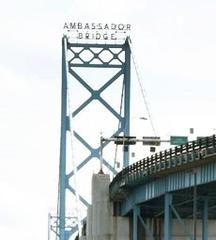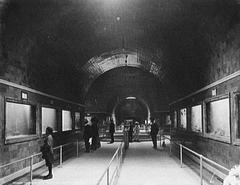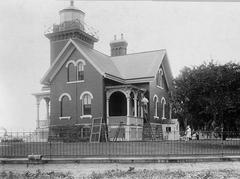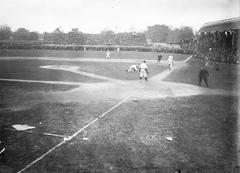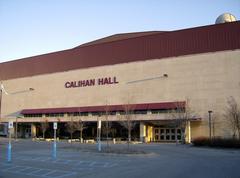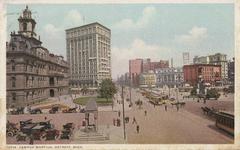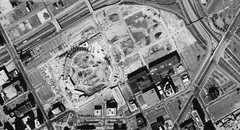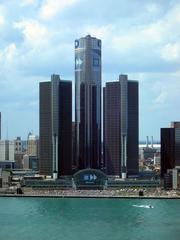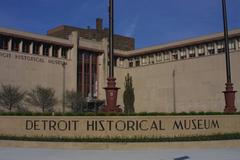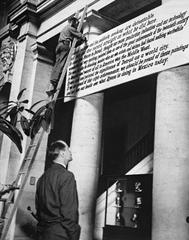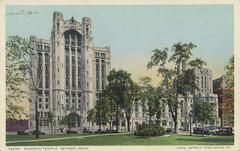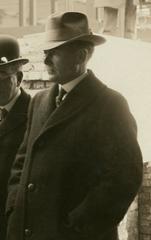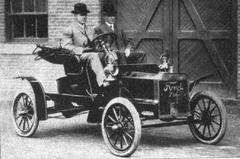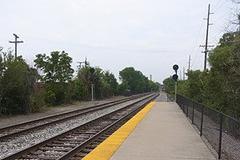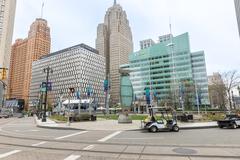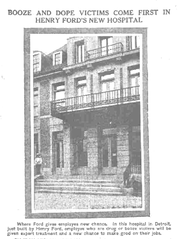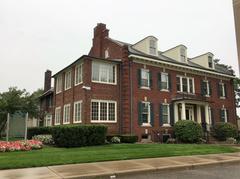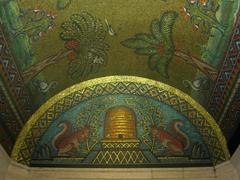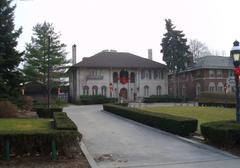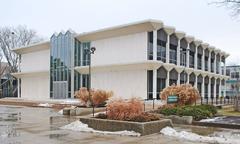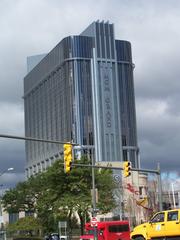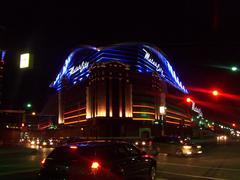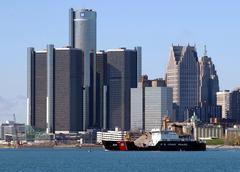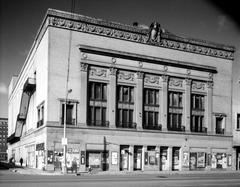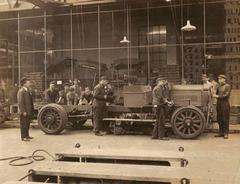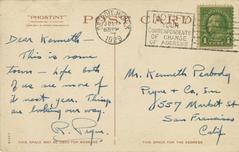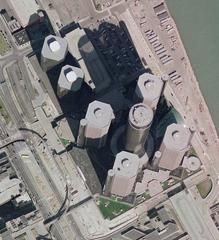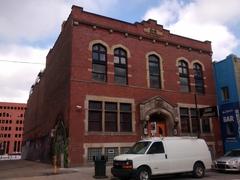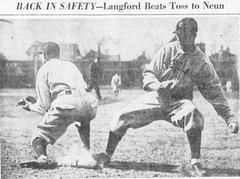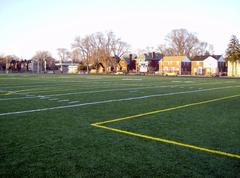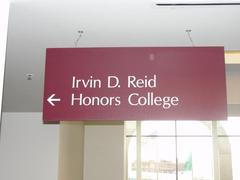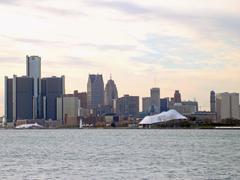
Garden Court Apartments Detroit: Visiting Hours, Tickets, and Historical Information
Date: 04/07/2025
Introduction
Situated along Detroit’s historic East Jefferson Avenue, the Garden Court Apartments—now known as Garden Court Condominiums—stand as an enduring symbol of early 20th-century architectural ambition and urban transformation. Designed in 1915 by the acclaimed architect Albert Kahn, this Beaux-Arts structure was originally built to serve Detroit’s growing upper-middle class during the city’s industrial boom. With its signature U-shaped footprint, elegant red brick and limestone façade, and intricate interior detailing, the building exemplifies both luxury and innovation from the era (Detroit Historical Society; Historic Detroit).
Although now a private residential complex, Garden Court’s historical and architectural significance makes it a point of interest for visitors and architecture enthusiasts alike. Its proximity to the Detroit River, Belle Isle Park, and the Detroit Riverwalk further enhances its appeal as part of a broader exploration of Detroit’s historical landmarks (Detroit History Tours; Metro Times). This comprehensive guide provides essential details for prospective visitors, including access policies, nearby attractions, architectural highlights, travel tips, and answers to frequently asked questions.
Table of Contents
- Historical Background and Significance
- Architectural Features and Preservation
- Visiting Information: Hours, Tickets, and Access
- Accessibility and Travel Tips
- Nearby Attractions and Photographic Opportunities
- Special Events and Cultural Context
- Frequently Asked Questions (FAQ)
- Summary and Visitor Tips
- References and External Links
Historical Background and Significance
Origins and Early Development
Commissioned by J. Harrington Walker, co-founder of the Hiram Walker & Sons distillery, Garden Court Apartments were constructed in 1915 to serve Detroit’s upper-middle class during a period of intense urban growth. Albert Kahn’s design reflected the era’s embrace of apartment living, transitioning from a city dominated by grand single-family homes to one adapting to higher-density urban living (Detroit Historical Society).
The building quickly established itself as a prestigious address, attracting business leaders, artists, and socialites. Its luxury amenities, including spacious floor plans, high ceilings, central heating, and elevators, were considered cutting-edge at the time (Historic Detroit).
Role in Detroit’s Urban Landscape
Garden Court Apartments played a pivotal role in shaping East Jefferson Avenue’s transition from an area of stately homes to a corridor of elegant apartment residences. This shift mirrored broader social changes, as more professionals and executives favored the convenience and amenities of apartment living close to Detroit’s commercial and cultural heart.
The building’s construction marked a milestone in Detroit’s densification, setting a benchmark for future high-rise residential developments in the city (Historic Detroit).
Architectural Features and Preservation
Exterior and Structure
Garden Court’s ten-story, U-shaped plan encloses a private landscaped courtyard—an innovative feature for its time. The red brick façade, limestone accents, decorative cornices, pilasters, and balustrades all reflect the Beaux-Arts style. The grand entrance, framed by a stately portico, leads into a marble-lined lobby that remains largely intact (Detroit Historical Society).
Interior Details
Apartments were designed to maximize natural light with large windows and multiple exposures. Many original interior details, such as ornate moldings, fireplaces, and built-in cabinetry, have been preserved or carefully restored. The building’s U-shaped configuration not only fosters a sense of community but also creates the signature courtyard visible from above.
Preservation Status
Garden Court Apartments were added to the National Register of Historic Places in 1985, underscoring their importance to Detroit’s architectural heritage and ensuring ongoing preservation (National Park Service).
Visiting Information: Hours, Tickets, and Access
Exterior Viewing
The building remains a private residence, so public access to interior spaces and the courtyard is restricted. However, the exterior and grounds can be viewed at any time from the street or sidewalk, making it a convenient stop on self-guided walking tours of East Jefferson Avenue.
Guided Tours and Special Events
Guided tours that include Garden Court Apartments are occasionally available as part of broader architectural or heritage tours. These may offer access to select common areas (such as the lobby or rooftop terrace) and provide historical context. To participate, consult local tour providers such as Detroit History Tours, especially during Detroit’s annual architectural heritage events.
Tickets
No tickets are required for exterior viewing. If interior access is offered during a special event or tour, advance booking and an admission fee may apply.
Accessibility and Travel Tips
- Location: 2900 East Jefferson Avenue, Detroit, MI.
- Transit: Easily accessible by car; street parking is available nearby, but limited.
- Public Transit: The People Mover and QLine streetcar provide convenient access from downtown; rideshare services (Uber, Lyft) are also recommended.
- Accessibility: Sidewalks and curb cuts support wheelchair access to the exterior; interior accessibility may vary and should be confirmed if joining a tour.
- Travel Tip: Comfortable footwear is recommended for walking tours. Early morning or late afternoon visits provide the best lighting for photography.
Nearby Attractions and Photographic Opportunities
Garden Court is ideally located for exploring:
- Detroit Riverwalk: A scenic promenade with river views.
- Belle Isle Park: Features gardens, a conservatory, and museums.
- Detroit Institute of Arts: Renowned for its art collection and Diego Rivera murals.
- Fisher Building: Another Albert Kahn masterpiece.
- Aretha Franklin Amphitheatre: Hosts concerts and cultural events.
- Local Dining: Atwater Brewery and The Rattlesnake Club are within walking distance (Liz in Detroit).
The building’s façade and landscaped courtyard are particularly photogenic, especially in soft morning or late afternoon light.
Special Events and Cultural Context
Garden Court’s historical significance is often celebrated during Detroit’s architecture tours, heritage festivals, and occasional open house events. The building has also appeared in film and television, including the sitcom “Martin” and the movie “LOL” (Metro Times).
Frequently Asked Questions (FAQ)
Q: Can the public enter Garden Court Apartments?
A: No, interior access is limited to residents and occasional guided tours or open house events.
Q: What are the visiting hours?
A: The exterior is viewable at any time. Check local tour operators for special tour dates.
Q: Are tickets required?
A: No tickets are needed for exterior viewing. Tickets may be required for tours or special events.
Q: Is the building wheelchair accessible?
A: Sidewalks and exterior areas are accessible. Contact tour providers regarding interior access.
Q: Where can I park?
A: Street parking is available on East Jefferson Avenue; public parking lots may also be nearby.
Q: Are there nearby attractions?
A: Yes—Detroit Riverwalk, Belle Isle Park, Detroit Institute of Arts, and more are close by.
Summary and Visitor Tips
Garden Court Apartments are a distinguished example of Detroit’s architectural legacy, encapsulating the city’s early 20th-century aspirations and Albert Kahn’s visionary design. While interior access is limited, the building’s stunning Beaux-Arts façade and prime location near major attractions make it a worthwhile stop for visitors. Respect resident privacy, leverage guided tours when available, and use public transport or rideshare for convenience. For the best experience, schedule visits during spring or fall and consider combining your trip with a broader exploration of Detroit’s historical and cultural sites.
For more detailed guides and event updates, visit the Detroit Historical Society and Historic Detroit. Download the Audiala app for curated tours, maps, and insider tips, and follow local heritage organizations for the latest news.
References and External Links
- Detroit Historical Society
- Historic Detroit
- National Park Service
- Detroit History Tours
- LocationsHub
- Metro Times
- Liz in Detroit
- Tourism Teacher
- Amber Everywhere
- Max Broock Detroit

